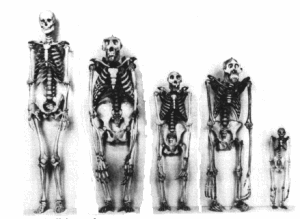
Throughout the course of human evolution, there have been plenty of firsts. Small changes in our genetic code have laid the groundwork for our bipedal gait, our large brains, and our ability to speak complex languages.
There are countless genes throughout the human genome that distinguish us from our evolutionary relatives; now scientists have found yet another example. However, unlike novel and uniquely human mutations like FOXP2 and MYH16, this gene has been nestled in suspended animation within our genomes for tens of millions of years: it just needed a wake-up call. In this week’s issue of PLoS Genetics , an international team of scientists investigates this gene’s unique history.
Their analysis centers on a family of genes known as Immunity Related GTPases (or, IRG). Most mammals have many copies of these types of genes, which play a vital role in helping the immune system resist pathogens like bacteria. But humans and our closest relatives – the Great Apes – have one IRG gene, IRGM. Yet our slightly more distant relatives, such as the monkeys, have no working copies of IRGM, or any other members of the IRG gene family.
How could it come to pass that we and the apes share more in common with mice – at least in terms of IRG – as opposed to other primates? That apparent discrepancy turned out to be central to understanding the genetic history of IRGM.
The answer, according to the geneticists, was relatively simple: When looking at the evolution of our species, going back tens of millions of years, it is clear that IRGM was never ‘erased’ from our genomes. Instead, it simply laid dormant, and it was not until the common ancestor of apes and humans split off from monkeys that IRGM awoke from its long slumber.
The exact reason that IRGM was reborn in species such as humans and apes, but not monkeys, is not yet completely understood. We do know, however, that the fact that most humans have a working copy of IRGM is quite fortuitous. As mentioned above, the IRG genes are essential to controlling bacteria, specifically by maintaining the delicate balance of bacterial growth and immune control in our intestines. Recent research has shown that those without a working copy of IRGM have a greater risk of developing Crohn’s Disease, in which an individual’s immune system begins attacking the friendly bacteria living in our guts. The results are chronic – and painful – digestive problems. Without a doubt, IRGM is beneficial to the health and well-being of our digestive system, and its role in decreasing the risks of Crohn’s Disease cannot be underestimated.
Beyond shedding light on the practical value of IRGM, this study has revealed the first instance of a gene being ‘reborn’ after lying dormant for millions of years. As the study’s team leader, University of Washington professor of Genomic Sciences Evan Eichler put it, “These findings tell us we shouldn’t count a gene out until it has been completely deleted.”
How many other resurrected genes are sprinkled throughout the human genome? As the field of genetics explores the hidden depths of our genomes, we can only begin to wonder how many similar discoveries await.



